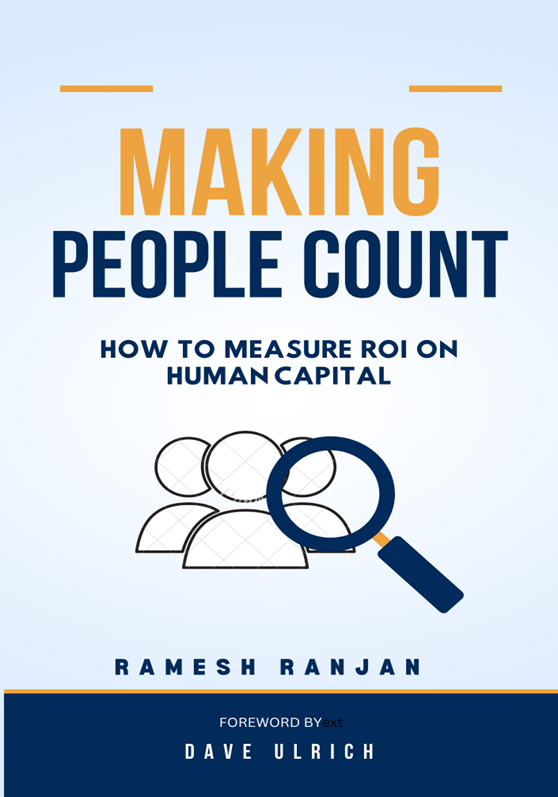Making People Count : How to measure the ROI on Human Capital


Discover the Future of HR with “Making People Count”
Unlock the potential of HR analytics and data-driven insights in “Making People Count: How to Measure the ROI on Human Capital” by Ramesh Ranjan. This book is your guide to HR success in the digital age.
- Explore 350+ HR Metrics
- Dive into AI and Algorithms
- Embrace Digital Transformation
Elevate your HR game and revolutionize your approach. Get your copy today and be the change your organization needs!
Join us on this journey to transform HR!
Chapters
1. Foreword
2. Acknowledgement
3. Data is the New Oil
4. Is HR Measureable
5. HR at the Seat on the Board
6. The Rise of Analytics
7. Evolution of HR
8. What is HR Analytics
9. Data driven HR for Business Impact
10. Why HR Analytics?
11. VOICE : Voice of Internal Customer Experience
12. Dimensions of HR Analytics
13. Information Maturity Model
14. HR Analytics Process
15. KPI’s and Metrics
16. Business Impact Metrics
17. Tools used in HR Analytics
18. HR Score Card
19. HR Story Telling
20. Data Visualization
21. Employee Life Cycle
22. Total Employee Experience
23. TEE Metrics
24. HR Metrics at each stage of Employee Experience
25. Artificial Intelligence (AI) in HR Analytics
26. Algorithms in HR Analytics
27. Chat GPT in HR Analytics
28. Predictive Analytics
29. Correlation of HR Variables
30. HR Analytics Journey (Implementation)
31. Using HR Analytics for targetted personalised HR Services
32. Limitations of HR Analytics
33. Data doesn’t tell the whole story
34. Data Quality
35. Data Privacy & Ethics
36. Future of HR Analytics
37. Conclusion
38. References

Author : Ramesh Ranjan

Professor, Startup Mentor, Business Consultant, Executive Coach, Content Manager & Editor
In a career spanning 4 decades, he has been Head of HR and held leadership positions in India & globally in organisations like Schneider Electric India, American Power Conversion (APC), Chevron Texaco/Caltex India, Praxair India, Co Systems India, Indian Herbs & ITI. He was VP-HR @ Schneider Electric India in his last role.
He is currently a Startup Mentor to a few Startups, an Executive Coach to a few CXO’s. He also provides Consulting Services in the area of Human Resources Management to a few companies.
He is also the Professor of Human Resources at IFIM School of Management besides being a visiting Professor at WE School, NMIMS, ISME, Jain University, XIME & Christ University Bangalore. He is also a visiting Professor at the Prague University of Economics & Business in Prague, Czech Republic.
He was the Vice President of NHRD Bangalore Chapter and was also the Honorary Secretary of the National HRD Network, Bangalore Chapter, member of the India HR Council of the AMCHAM, New Delhi, Member of the Roundtable of HR Directors of Petroleum Companies, and Member of the India HR Council of Conference Board.
He strongly believes that “when the going gets tough, the tough gets going”. You can know more about him @ https://rameshranjan.in
Global Leaders Reviews

Ramesh’s book advances analytics because he offers specific ideas, tools, and examples that confirms the value of analytics with discipline and accessibility. Ramesh’s insights show the evolution of how analytics creates value to Business.
As human capability (talent + leadership + organization + HR function) becomes more relevant for stakeholder value, analytics will become the means to make it happen.
This outstanding book will enable this journey.

Ramesh has brought out a very interesting book on the investment that is made in people and how that is to be measured and optimized. Normally there is a notion of return on investment or return on capital deployed for goods and services. This for the first time, perhaps, there is a comprehensive approach to looking at investment in people and the ROI derived through rigorous and comprehensive metrics and data.
Data to information, to analytics, insights that need to be actioned, is well delineated. The flip side is that just sometimes, many of the people side of contributions cannot be quantified. The book treads the line of the art of the possible and for the reader to draw their conclusions. A must read for CHROs and business leaders.



